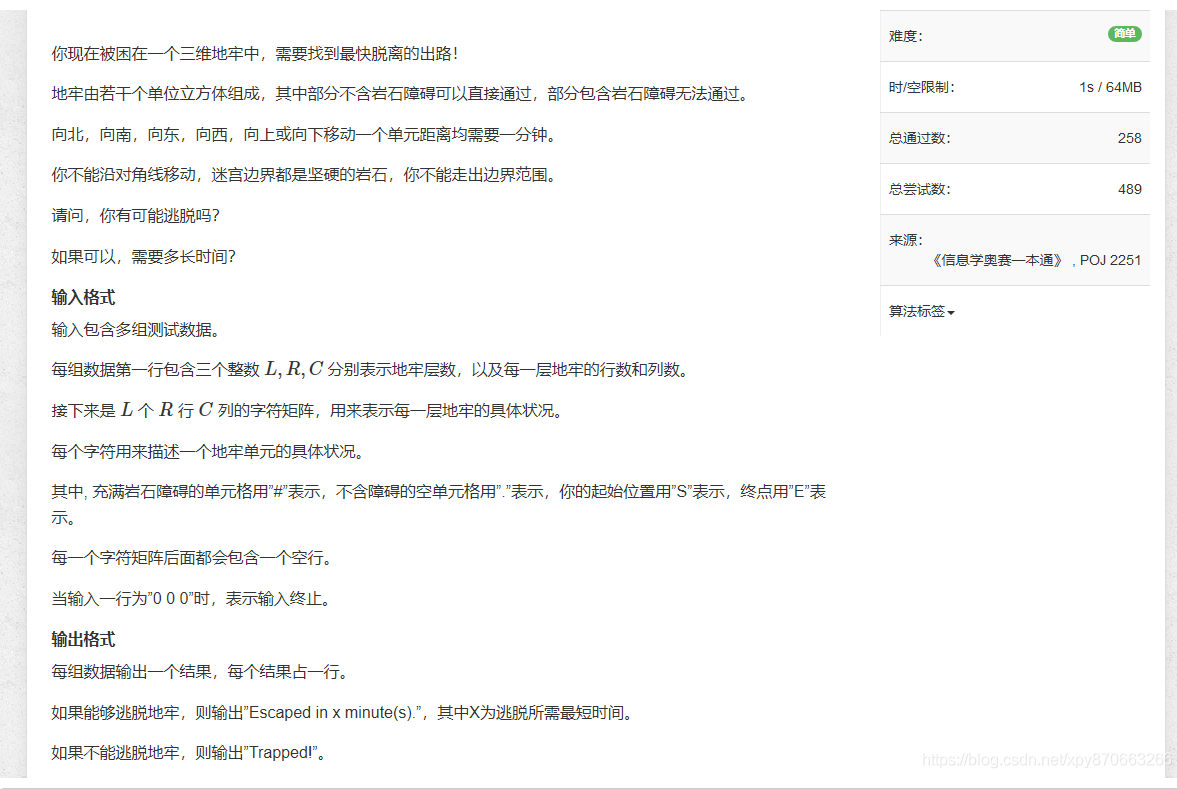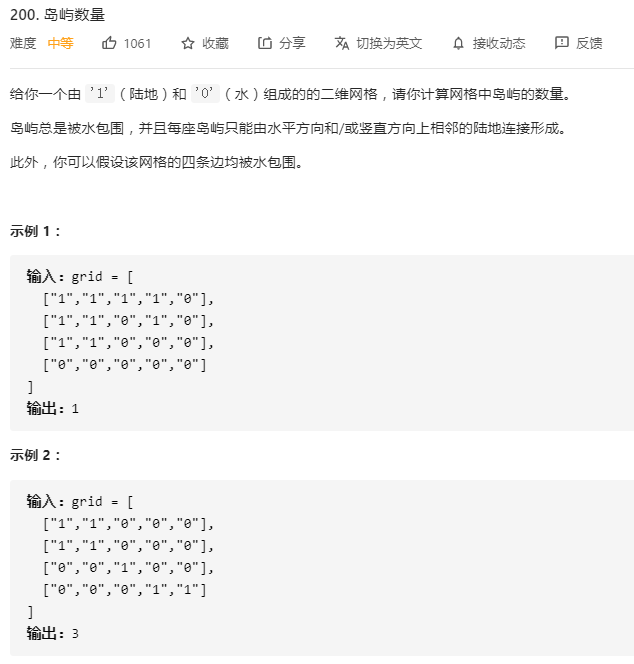二维
1、岛屿数量
(1)、遇到1就DFS
class Solution:def numIslands(self, grid: List[List[str]]) -> int:if not grid: return 0row = len(grid)col = len(grid[0])cnt = 0def dfs(i, j):grid[i][j] = "0" # 设置为0,防止重复访问for x, y in [[-1, 0], [1, 0], [0, -1], [0, 1]]:tmp_i = i + xtmp_j = j + yif 0 <= tmp_i < row and 0 <= tmp_j < col and grid[tmp_i][tmp_j] == "1":dfs(tmp_i, tmp_j)for i in range(row):for j in range(col):if grid[i][j] == "1":dfs(i, j)cnt += 1return cnt
(2)、遇到1就BFS
这两个没有什么区别,因为BFS没有终止条件,两个方法都把1遍历完了
class Solution:def numIslands(self, grid: List[List[str]]) -> int:from collections import dequeif not grid: return 0row = len(grid)col = len(grid[0])cnt = 0def bfs(i, j):queue = deque()queue.appendleft((i, j))grid[i][j] = "0"while queue:i, j = queue.pop()for x, y in [[-1, 0], [1, 0], [0, -1], [0, 1]]:tmp_i = i + xtmp_j = j + yif 0 <= tmp_i < row and 0 <= tmp_j < col and grid[tmp_i][tmp_j] == "1":grid[tmp_i][tmp_j] = "0"queue.appendleft((tmp_i, tmp_j))for i in range(row):for j in range(col):if grid[i][j] == "1":bfs(i, j)cnt += 1return cnt
2、允许对称转移的二维迷宫
多考虑一种走法
import sysfrom collections import dequedef check(grid, x, y, s):return 0 <= x < len(grid) and 0 <= y < len(grid[0]) and 0 <= s <= 5 and grid[x][y] != '#'def bfs(grid, x, y, s):n, m = len(grid), len(grid[0])queue = deque()# 事实上有了res表,不用再使用最后一位来记录结果了,而且(x,y,s)才是定义的搜索状态。但是这样写可以与不用res表的代码统一起来queue.append((x, y, s, 0))# 转移表,每个二元组表示x和y的增量transitions = [[-1, 0], [1, 0], [0, -1], [0, 1]] # s坐标后面手动控制其转移# 搜索状态定义为(x,y,s),所以不再适合直接使用原矩阵记录是否已经访问# 这里设置res来保存搜索结果,默认值-1还可以用于判断是否已经访问res = [[[-1 for _ in range(5)] for _ in range(m)] for _ in range(n)]res[x][y][s] = 0 # 设置起点的最小时间代价为0while queue:x, y, s, t = queue.popleft()for i in range(5): # 5种走法:上下左右以及对称if i < 4: # 上下左右可以使用transitions统一处理d = transitions[i]nx, ny, ns, nt = x + d[0], y + d[1], s, t + 1else: # 对称转移时,新坐标不是简单用一个增量加到原坐标,而是原坐标的函数,所以手动控制转移结果nx, ny, ns, nt = n - 1 - x, m - 1 - y, s + 1, t + 1if check(grid, nx, ny, ns) and res[nx][ny][ns] == -1: # 如果下一个状态是合法的,且未访问过if grid[nx][ny] == 'E': # 如果是所求的终点,返回对应的结果时间return ntqueue.append((nx, ny, ns, nt)) # 否则入队,后续再访问其邻接结点res[nx][ny][ns] = nt # 记录到达该结点的最小时间,同时也表示已经访问过return -1# 起点状态,x、y为箱子的左上角格子坐标,s为已经使用飞行器的次数,t为步数/时间time = bfs(grid, x, y, s)print(time)
2.5维
1、推箱子

import sysfrom collections import dequedef parse_nums(nums_str):return [int(x) for x in nums_str.strip().split()]def check(grid, x, y, s):if x < 0 or x > len(grid) or y < 0 or y > len(grid[0]):return False # 如果出界,不合法if grid[x][y] == '#':return False # 如果箱子的坐标对应的格子是禁地,不合法if s == 0 and grid[x][y] == 'E':return False # 如果箱子是竖着的,则箱子对应坐标是易碎也不合法if s == 1 and grid[x][y + 1] == '#':return False # 如果箱子是左右的,则箱子的另一个格子如果是禁地也不合法if s == 2 and grid[x + 1][y] == '#':return False # 如果箱子是上下的,则箱子的另一个格子如果是禁地也不合法return Truedef bfs(grid, x, y, s):queue = deque()# 事实上有了res表,不用再使用最后一位来记录结果了,而且(x,y,s)才是定义的搜索状态。但是这样写可以与不用res表的代码统一起来queue.append((x, y, s, 0))# 转移表,每个三元组的前两个表示x和y的增量,第三个表示箱子姿势的转移transitions = [[[-2, 0, 2], [1, 0, 2], [0, -2, 1], [0, 1, 1]], # 姿势为竖着对应的4个方向的x,y,s如何转移[[-1, 0, 1], [1, 0, 1], [0, -1, 0], [0, 2, 0]], # 姿势为左右对应的4个方向的x,y,s如何转移[[-1, 0, 0], [2, 0, 0], [0, -1, 2], [0, 1, 2]]] # 姿势为上下对应的4个方向的x,y,s如何转移# 搜索状态定义为(x,y,s),所以不再适合直接使用原矩阵记录是否已经访问# 这里设置res来保存搜索结果,默认值-1还可以用于判断是否已经访问res = [[[-1 for _ in range(3)] for _ in range(len(grid[0]))] for _ in range(len(grid))]res[x][y][s] = 0 # 设置起点的最小时间代价为0while queue:x, y, s, t = queue.popleft()for d in transitions[s]: # 用s取出转移表中对应的行nx, ny, ns, nt = x + d[0], y + d[1], d[2], t + 1 # 状态转移与结果记录(注意d[2]不是增量,所以ns=d[2]而不是=s+d[2])if check(grid, nx, ny, ns) and res[nx][ny][ns] == -1: # 如果下一个状态是合法的,且未访问过if grid[nx][ny] == 'O' and ns == 0: # 如果是所求的终点,返回对应的结果时间return ntqueue.append((nx, ny, ns, nt)) # 否则入队,后续再访问其邻接结点res[nx][ny][ns] = nt # 记录到达该结点的最小时间,同时也表示已经访问过return -1# 读取2维地图for ns in sys.stdin:if ns == '0 0': # 终止信号breakN, M = parse_nums(ns)grid = []# 起点状态,x、y为箱子的左上角格子坐标,s为箱子姿势(0为竖着,1为左右躺着,2为上下躺着),t为步数/时间x, y, s, t = 0, 0, 0, 0first_X = Truefor i in range(N):row = [c for c in input()]if 'X' in row:if first_X: # 第一次碰到X,就能判断是否为左右躺着,否则先默认竖着x, y, s = i, row.index('X'), 0if row[y + 1] == 'X':s = 1first_X = Falseelse: # 如果碰到了两行中都有X,则是上下躺着s = 2grid.append(row)time = bfs(grid, x, y, s)print(time if time != -1 else 'Impossible')
三维
1、迷宫
import sysfrom collections import dequedef parse_nums(nums_str):return [int(x) for x in nums_str.strip().split()]def bfs(grid, x, y, z):queue = deque()queue.append((x, y, z, 0))grid[x][y][z] = '#' # 不走回头路while queue:directions = [[1, 0, 0], [-1, 0, 0], [0, 1, 0], [0, -1, 0], [0, 0, 1], [0, 0, -1]]x, y, z, t = queue.popleft()for d in directions: # 选择列表nx, ny, nz, nt = x + d[0], y + d[1], z + d[2], t + 1 # 索引if 0 <= nx < len(grid) and 0 <= ny < len(grid[0])and 0 <= nz < len(grid[0][0]) and grid[nx][ny][nz] != '#': # 满足条件,加入队列if grid[nx][ny][nz] == 'E':return ntqueue.append((nx, ny, nz, nt))grid[nx][ny][nz] = '#' # 不走回头路return -1for ns in sys.stdin:if ns == '0 0 0': # 终止信号breakL, R, C = parse_nums(ns) # 层数、行数、列数grid = []x, y, z = 0, 0, 0for i in range(L):level = []for j in range(R):row = [c for c in input()]if 'S' in row: # 起始点x, y, z = i, j, row.index('S')level.append(row)grid.append(level)input() # 丢弃空行time = bfs(grid, x, y, z)print("Trapped!" if time == -1 else f"Escaped in {time} minute(s).")
进阶版 会掉血
def bfs(grid, x, y, z):queue = deque()queue.append((x, y, z, 0))grid[x][y][z] = '#' # 不走回头路while queue:directions = [[1, 0, 0], [-1, 0, 0], [0, 1, 0], [0, -1, 0], [0, 0, 1], [0, 0, -1]]x, y, z, t, n = queue.popleft()for d in directions: # 选择列表nx, ny, nz, nt = x + d[0], y + d[1], z + d[2], t + 1 # 索引if 0 <= nx < len(grid) and 0 <= ny < len(grid[0]) and 0 <= nz < len(grid[0][0])and grid[nx][ny][nz] != '#' and nn>0: # 满足条件,加入队列if grid[nx][ny][nz] == 'E':return ntif grid[nx][ny][nz]=='*'":nn-=1else:nn=nnqueue.append((nx, ny, nz, nt, nn))grid[nx][ny][nz] = '#' # 不走回头路return -1


